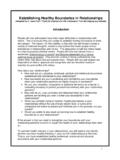Transcription of Behavioral Models of Depression: A Critique of the ... - ed
1 International Journal of Behavioral Consultation and Therapy Volume 4, No. 2, 2008. Behavioral Models of Depression: A Critique of the Emphasis on Positive Reinforcement Paulo Roberto Abreu & Carlos E. Santos Abstract This paper provides a review of Behavioral Models of depression highlighting the problems associated with its historical emphasis on lowered frequencies of positive reinforcement. We analyzed the Models of Ferster and Lewinsohn in their theoretical approach, methodology and application. We conducted a review of the suppressive characteristics exercised by punishment, by the presentation of non-contingent aversive stimulation and by operant extinction. A number of recommendations are made concerning how these processes can inform interventions.
2 We conclude that interventions geared towards identifying aversive control play a promising role in clinical change in the treatment of depression. Keywords: Aversive Control, Response-Contingent Positive Reinforcement, Depression, Clinical Behavior Analysis, Functional Assessment, Behavioral Activation. The present article aims to revisit the principles of Behavioral Models of depression by emphasizing advancements in the field, as well as providing a Critique of the dominant Models . With this goal in mind, we aim to re-direct the conceptual analysis towards an understanding of the environmental variables frequently observed in the behaviors of depressed individuals. Drawing from the existing literature, we propose possible variables associated with Behavioral suppression and its mechanisms during the development and course of depressive behavior repertories.
3 Three particular Behavioral processes are considered: (1) suppressive characteristics exercised by punishment, (2) the presentation of non-contingent aversive stimulation, and (3). operant extinction. We begin with a discussion of the dominant Models of depression, followed by a Critique , and we conclude with a discussion of how each of these processes can inform clinical interventions. Models of depression Behavioral analysis, in addition to advocating for a pragmatic approach to control and prediction of behavior (Skinner 1974/1976), is concerned with promoting an understanding of clinical phenomenon in order to create effective interventions. With this goal in mind, Behavioral analysis has studied depression for decades, describing this type of Behavioral phenomena along contextual and Behavioral lines.
4 In order to understand Behavioral variations observed in depressed clients, it is necessary to understand the variables responsible as cause and maintenance of the feelings of dysphoria present throughout the history of the individual. This process can be reached by identifying the depressive . contingencies, which involves identifying the antecedent events and consequences of the depressive behaviors of interest. Taken together, the problem behaviors, the antecedent and consequential events form the unit of analysis referred to as triple contingency (Skinner, 1953/1965). Behavioral analysis focuses on the application of this analytical tool in order to understand the context in which depressive repertories are taking place. This perspective offers possibilities of clinical interventions.
5 Examples of interventions afforded by this perspective can be found today in various private and public practice settings. Given this emphasis on a contextualized understanding of the problems associated with depressive behaviors (Jacobson, 1997; Hayes, Hayes, & Reese, 1998), the study of depression gained momentum with the publication of a 1973 article written by Charles Ferster and published in the 130. International Journal of Behavioral Consultation and Therapy Volume 4, No. 2, 2008. American Psychologist. Ferster (1973) proposed a functional analysis of depressive behaviors building on the cumulative knowledge reached by previous base studies (Ferster, 1967; Ferster, Culbertson, & Boren, 1968; Ferster & Skinner, 1957/1997). Functional analysis, in this context, refers to how certain contextual factors in the environment of the individual influences behaviors.
6 The functional analysis model proposed by Ferster has influenced the work of many practitioners and researchers today; however, research on the effic acy of this model lacked rigorous evaluation and interventions to validate Ferster's theoretical contribution (Kanter, Callaghan, Landes, Busch, & Brown, 2004). This lack of empirical work was later addressed by the work of Peter Lewinsohn. Lewinsohn adopted most of Ferster's model while also adding significant findings through his own research (Blaney, 1980, Lewinsohn, Biglan, & Zeiss, 1976). Ferster's conceptual analysis, coupled by the empirical work done by Lewinsohn, provided the initial basis of applied studies in depression, laying the foundation for the development of modern Behavioral analytic treatment.
7 Ferster (1973) stated that certain characte ristics of the depressed person such as excessive crying, irritability and self-criticism is associated with the loss of other types of activities. The variables that are influencing this type of repertory are lowered frequency of positive reinforcement and the increase of negative reinforcement (Ferster, 1973). Positive reinforcement occurs through events that heighten the frequency of behaviors observed in non-depressed indiv iduals, such as behaviors associated with the experience of having a positive and fulfilling relationship with a significant other, feeling productive at work or relating to friends , among others. Negative reinforcement, on the other hand, refers to a heightening of the frequency of avoidance or escaping behaviors associated with an aversive stimulation.
8 Avoidance behaviors are evidenced, for instance, in a situation where a depressed worker avoids tenuously being face to face with his or her boss. The avoidance of a potential conflict can maintain the non-resolution of the problem and with it perpetuate the suffering. Escape behaviors occur when a depressed individual escapes undesirable situations, such as by abandoning responsibilities at work and at home, or even in everyday situations when an individual finds excuses to isolate him or herself from being in the presence of friends. Hypotheses have been proposed concerning the determinants of lowered frequency of positive reinforcement. These include sudden changes in the environment of the depressed individual. Sudden changes offer life circumstances similar to contingencies of schedules of reinforcement in high-fixed ratios.
9 When the effort necessary for the production of reinforcement is too high, there are pauses among reinforcements. This effect is known in the literature as abulia. Sudden changes in the environment are noticeable in situations where the individual moves out of his or her residency to a setting where they no longer possess a social network that can operate as a source of positive reinforcement. A high response cost can be observed in professional situations in which the employee is required to work beyond normal expectations. When a task is complete, there is a slowed response to the next task. If the work constitutes an inevitable high effort, then it becomes likely to identify abulia. Overtime pay or additional benefits provided by corporations are good examples of companies attempting to exert influence over this type of intense effort.
10 Lewinsohn's model was similar to Ferster's in that it recognized that feelings of disphoria of a depressive person would be the result of a reduction of the positively reinforced behaviors. The author coined the term response-contingent positive reinforcement to refer with greater emphasis to this singular characteristic of the repertory of the depressed (Lewinsohn et al., 1976). According to Lewinsohn and colleagues (1976), there are three ways to explain the low rates of response-contingent positive responses. One would be a loss of reinforcement effectiveness of events which formerly used to serve as positive reinforcers. Another might be that a change in the individual's environment could cause the former reinforcer to no longer be available. Third, the reinforcer might still be available in the environment however, the individual may no longer have the ability to access it.
















